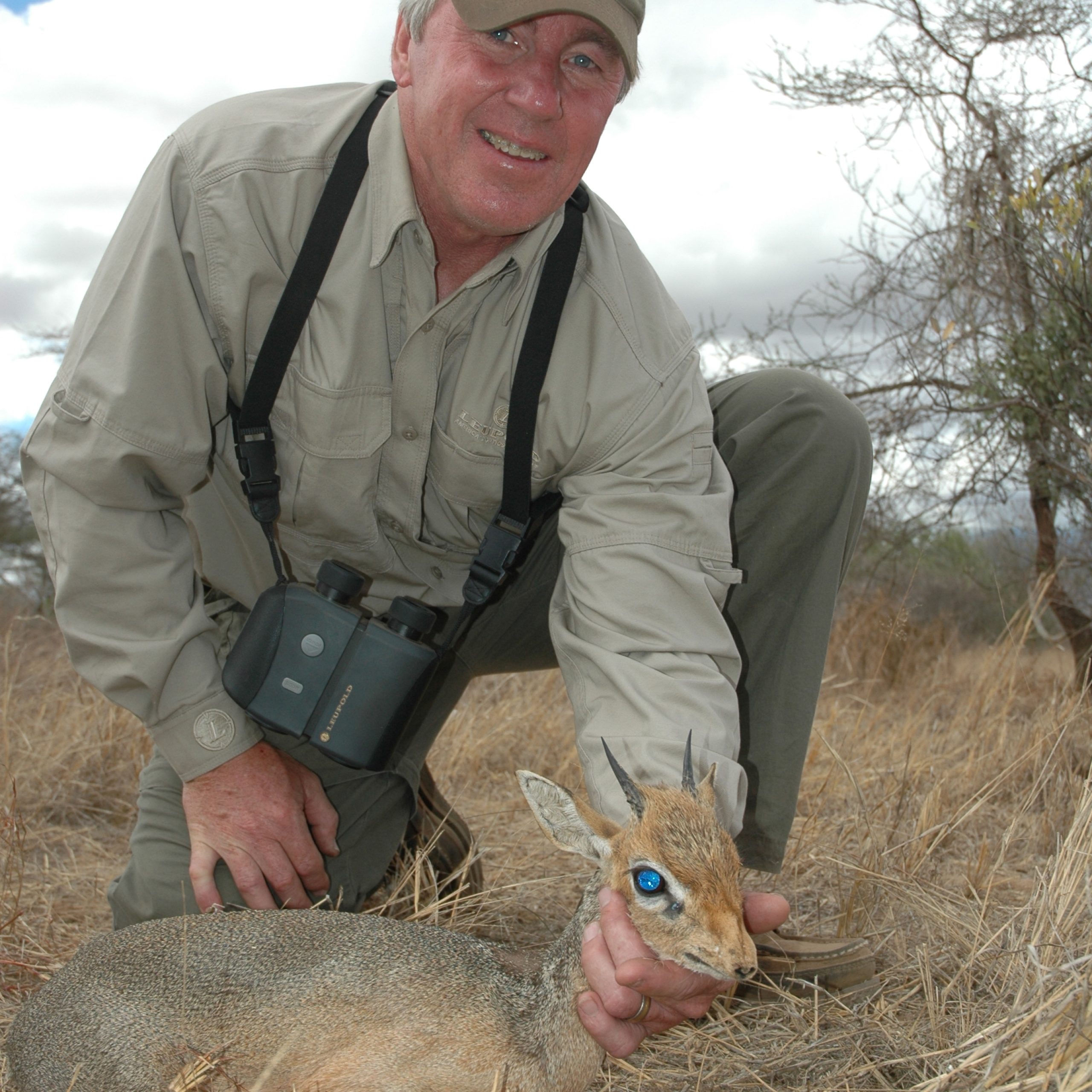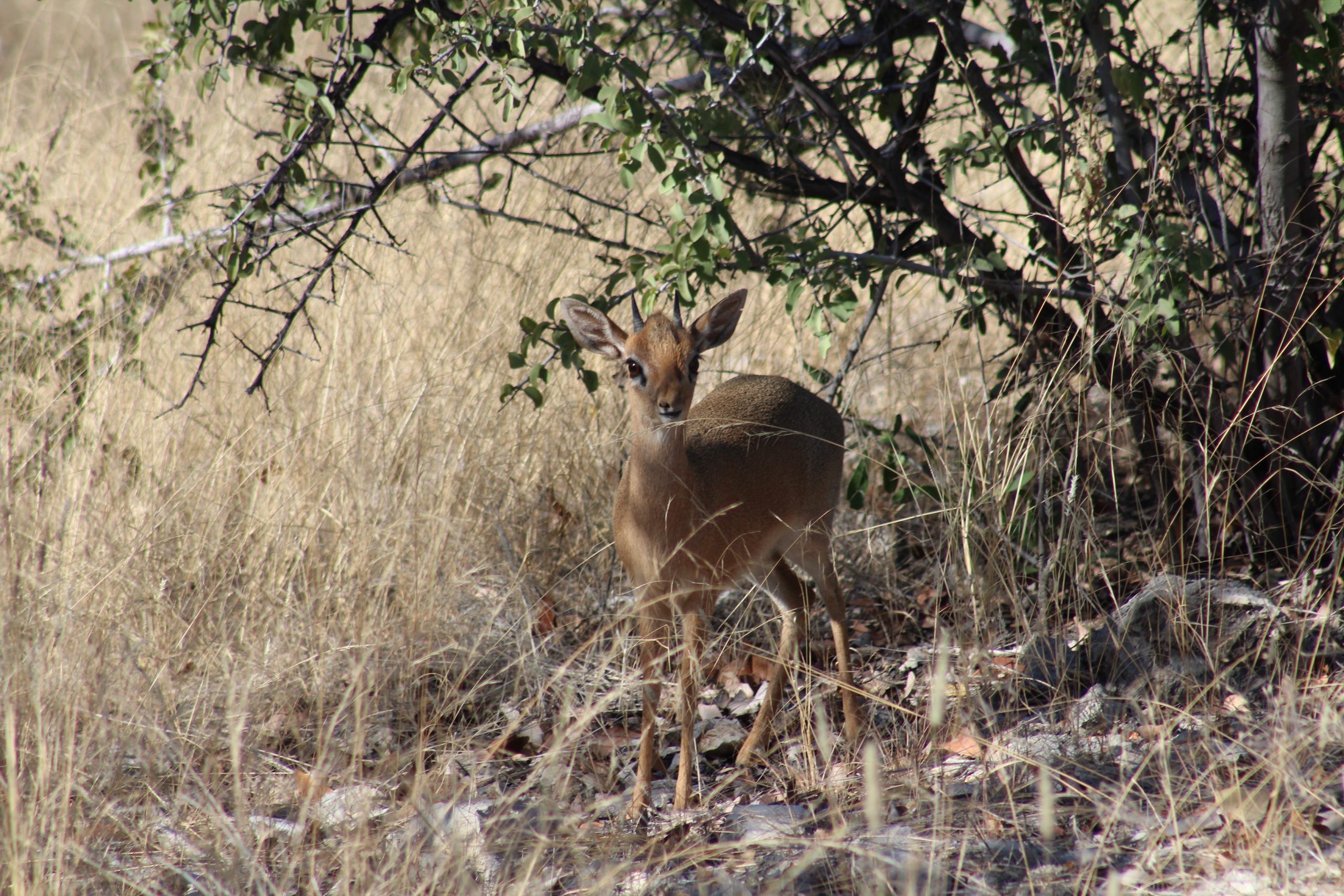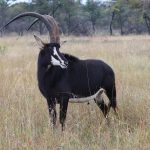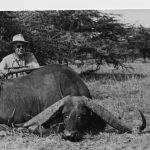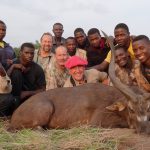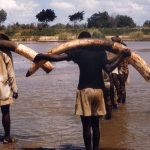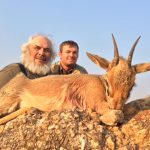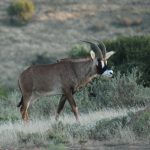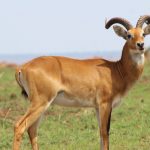These small antelopes are part of Africa’s Tiny Ten.
Photo above: A fine Damara dik-dik ram.
Get your mind out of the gutter. The dik-diks are tiny African antelopes, adapted to arid, semi-desert thornbush. The name comes from Somali, mimicking the female’s chirping alarm call.
Dik-diks are sort of gray to almost rufous, with a distinctive bulbous snout, and a forehead tuft that makes it tricky to see the male’s small, ringed, needle-sharp horns. Depending on race, dik-diks weigh six to maybe thirteen pounds, pencil-legged, a foot to possibly a foot-and-a-half tall. Think “small jackrabbit.” Most of the races have produced horns up to four inches, but three-inch horns are always spectacular. That’s the Rowland Ward minimum for the most-hunted Kirk’s dik-dik of southern Kenya and Tanzania. The Rowland Ward minimum for Namibia’s Damara dik-dik and Guenther’s dik-dik is 2.5 inches–not much horn to look for peeking past the forehead tuft.
Like all dwarf antelopes, dik-diks are tender and tasty, with meat more like a rabbit than an antelope. Although a dik-dik will be savored, they are too small to provide adequate camp fare, and too small for most larger predators to bother with. To many hunters, however, despite its small size, the dik-dik is a major trophy animal, requiring effort and expense.
At least twenty species of dik-diks have been proposed. To this day, their exact differences, boundaries, and classification are debated. With one exception, dik-diks are found only in northeast Africa. The largest one, the Damara dik-dik, is found in northwest Namibia and into Angola. That means the Damara is separated from other dik-diks by a huge stretch of Africa. In animal distribution, such a gap is unusual.
All dik-diks are of genus Madoqua, divided into long-snouted, and short-snouted groups. Damara, Kirk’s, and Guenther’s are considered long-snouted dik-diks. Despite the huge separation, Kirk’s is geographically closest to the isolated Damara, while Guenther’s ranges to the north of Kirk’s. Rowland Ward identifies five short-snouted dik-diks. SCI categorizes six, and their nomenclature is not in agreement. To some extent, it’s a moot point, because several races are found in Somalia, Djibouti, and Eritria, which are not open to hunting. Within living memory, it has never been possible to hunt all the dik-diks.
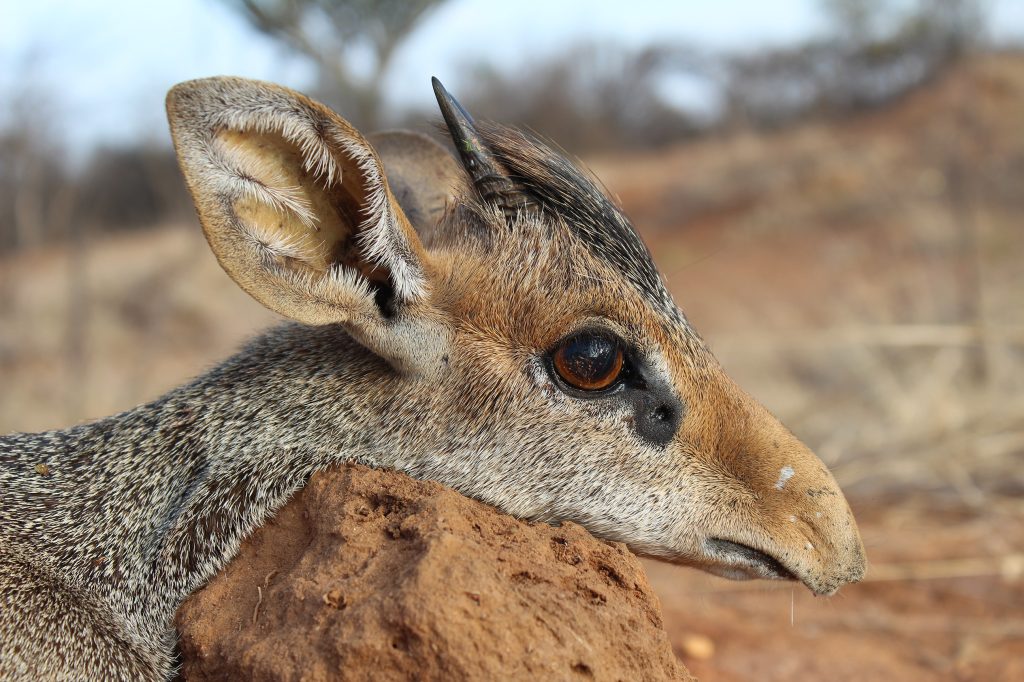
Depending on which authority one prefers, Ethiopia has four or five distinct races. You’d have to travel the length and breadth of that huge country to hunt them all. Currently, the most huntable dik-diks are probably the Damara in Namibia, Kirk’s in Tanzania, Guenther’s in the northeast corner of Uganda and southern Ethiopia, and Harar and Salt’s dik-dik, also in Ethiopia.
This last is in some dispute. Rowland Ward considers all dik-diks in northern Ethiopia to be Salt’s, this species ranging on through Djibouti and Eritria to Sudan. SCI considers the dik-diks of Ethiopia’s Awash River basin to be a smaller subspecies of Salt’s, called Cordeaux (M. saltiana cordeauxi). In 1993, Joe Bishop and I camped on the Awash and hunted this dik-dik. I’m no expert and can only say that these were very small, visibly half the size of the Damara.
Thanks to Namibia’s large outfitting industry and good management, the Damara is the least costly to hunt. When I first hunted what is now Namibia in 1979, I saw several dik-diks, but at the time they were fully protected. A quarter-century later, one of these little antelopes was a primary goal of a Namibian safari. Then, the “Tiny Ten” of Southern Africa had not been proposed; I just wanted one of these cool little guys. Today, the popularity of the Damara dik-dik has increased because of its necessity for the Tiny Ten. Value promotes protection, which equals more animals. Numbers and availability have increased, although the Damara dik-dik remains a limited-permit animal in Namibia.
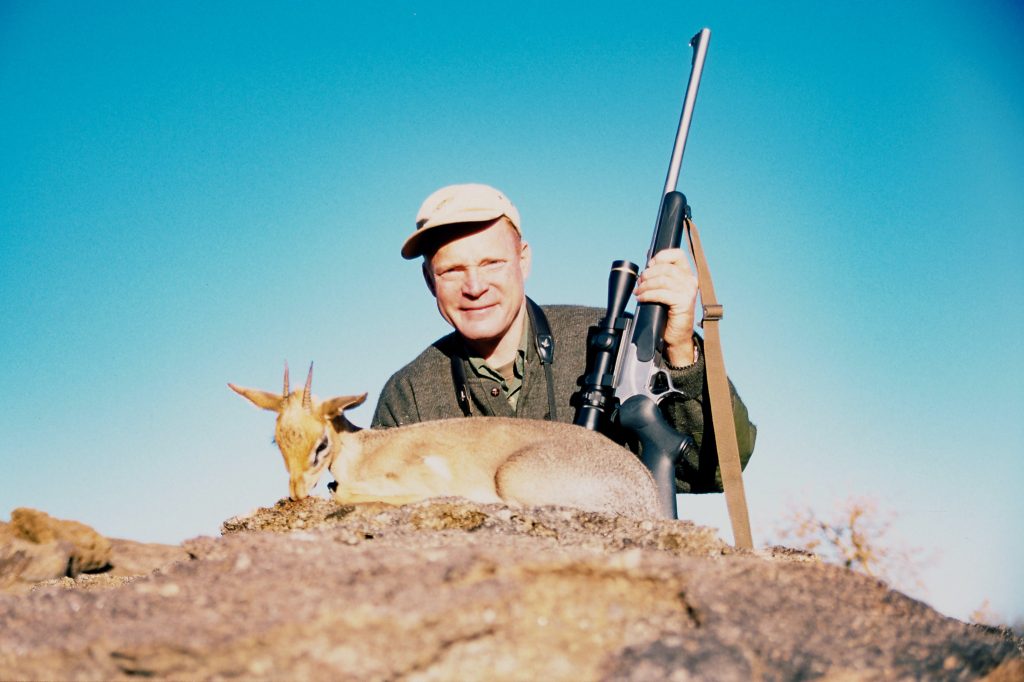
I’ve accompanied several hunts for the Damara dik-dik, so I have some experience with that one. I took an excellent Kirk’s dik-dik in Kenya, likewise have seen many in Tanzania, so I also have a little experience there. Joe and I had no trouble finding Cordeaux dik-diks in Ethiopia, but that’s my only experience with a “short-snouted” variety. On my second Uganda hunt in 2017, a Guenther’s dik-dik was at the top of my wish list. From our buffalo camp in Karamoja, we had to go far east near the Kenya border. Once in the dik-dik area, we saw plenty.
Based on this limited experience, all dik-dik hunting seems similar. You look in dry thornbush, glass into shadows. Adults are usually seen in pairs, sometimes with smaller offspring. Dik-diks tend to mate for life, so if a hornless dik-dik is seen, keep looking. Her mate is likely close-by.
Dik-diks are highly territorial. If spooked (as usual) they will scamper off. Don’t panic. Sit tight, or back off and come in from a different angle. Give it a half-hour and they often come slipping back. My Damara, at the time a giant, was taken that way. We spooked a pair from some bushes below a rocky kopje. Hunting with Dirk de Bod, we circled up into the rocks, came back down, and sat among some boulders. Wasn’t long before the female drifted back, soon followed by the big male.
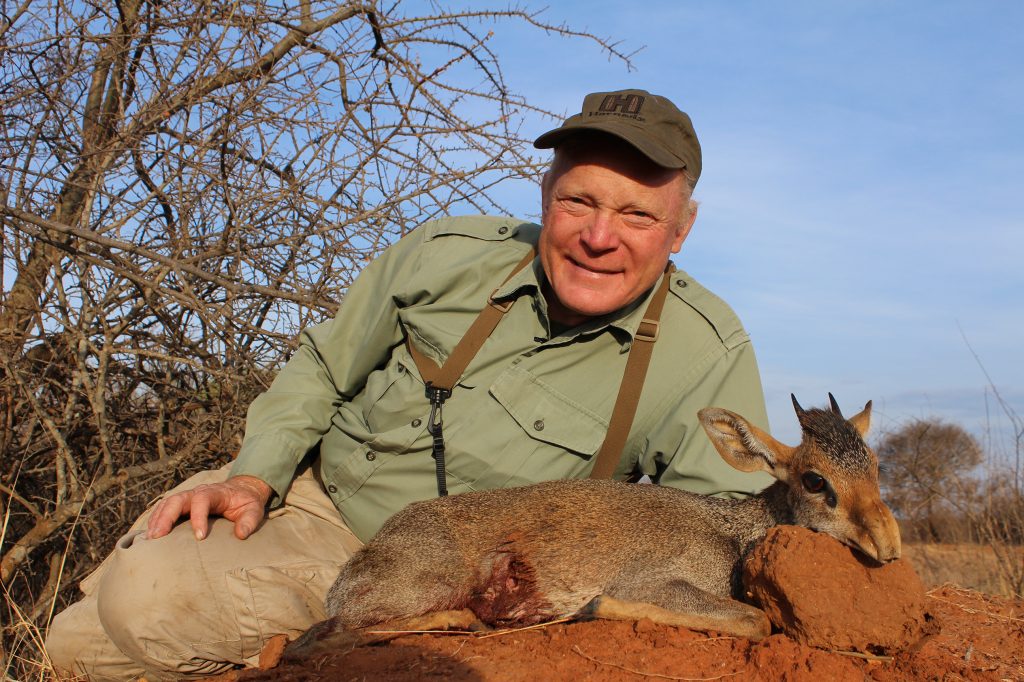
Many are taken in chance encounters. Always, you know dik-diks are in the area, on license, and on your wish list. When you see good horns, you take the shot. With this little antelope, the quandary is what to shoot him with. The dik-dik is a special animal, worthy of a life-size mount (which takes up little space) The problem: Taking him effectively without making a mess.
Cover-dwelling dwarf antelopes like forest duikers are customarily taken with shotguns, avoiding cape damage. Dik-diks are nervous little guys living in semi-open scrub, rarely taken within effective shotgun range. The challenge with a rifle is to avoid destruction, so we need accuracy without excessive power.
In Ethiopia, we used outfitter Colonel Negussie’s scoped Brno in .22 rimfire. In Namibia, daughter Brittany used Dirk de Bod’s son’s youth model .22. Placed well, a .22 Long Rifle hollowpoint is adequate, and a .22 is present in most camps. However, effective range is limited. Because of their small size and ability to hide behind a few blades of grass, rarely can dik-diks be seen and judged at distance. Up close, they’re likely to bolt before horns can be judged. In my experience. many opportunities are between 60 and 100 yards, pushing the limits of a .22 LR.
In Kenya, I carried a few 180-grain full-metal-jacket Match loads, which shot to the same point of impact as my 180-grain Nosler Partitions. I figured they’d be perfect for dik-diks and duikers. That was the last and only time I carried two loads for a plains game rifle! It was too complicated to try to switch when an animal was spotted. I managed it on the dik-dik, but even with a solid, the .30-06 was far too powerful. We salvaged only a shoulder mount, a shame for a beautiful dik-dik.
In Uganda in 2017, Steve Hornady brought a .223, which I borrowed for my Guenther’s. I purposefully shot it too far back, and dropped the animal without irreparable damage, but it was still too much gun. On other hunts in Namibia, Trijicon’s Stephen Bindon and my wife Donna used camp .17 HMRs for Damara dik-diks. They were perfect, plenty of range and power, almost no damage. That outfitter, Corne Kruger, happens to have .17 HMR rifles in camp, but they’re not common in Africa.
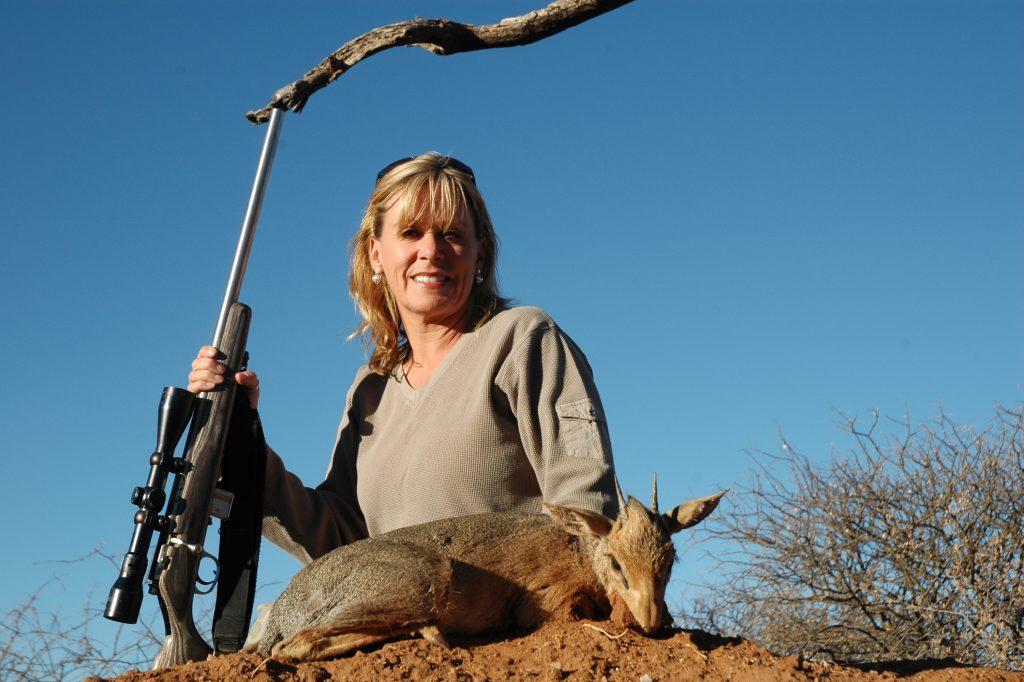
When I went for my Damara dik-dik, I took a .22 Hornet barrel for a T/C Encore. We shot two, one for me and one for Dirk, both down on the spot, no visible damage. Since then, I’m convinced the .22 Hornet is ideal for small antelopes. And, unlike the .17 HMR and .22 WMR, it is also versatile, powerful enough for antelopes up to reedbuck and impala. Realistically, it’s awkward to take any rifle on safari that’s perfect for just one animal. So, for a highly specialized animal like dik-dik, we often borrow a camp gun. It makes sense to find out what might be available.
The .22 Hornet remains surprisingly popular in southern Africa. A couple years ago, Harley Young, at eighty-something, came to Frontier Safaris in Namibia needing a klipspringer and Damara dik-dik to complete his Tiny Ten. His 6.5 Creedmoor was perfect for the klippie, but that’s a cannon on dik-dik. Barry Burchell had an Anschutz .22 Hornet but no ammo, so we repaired to his loading bench and whomped up a few rounds, then checked zero. A day later, Harley had a fine Damara dik-dik with a perfect skin.
